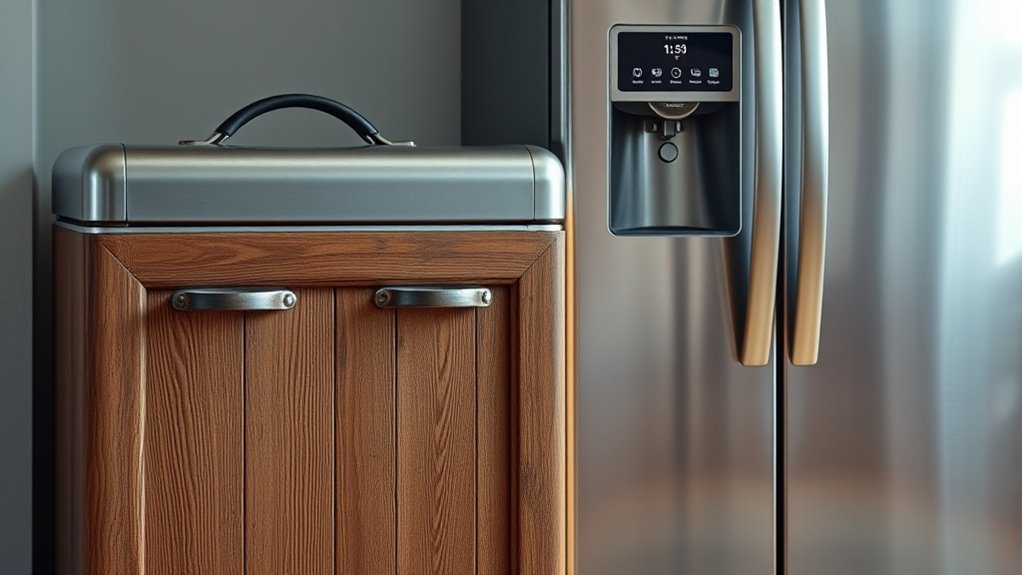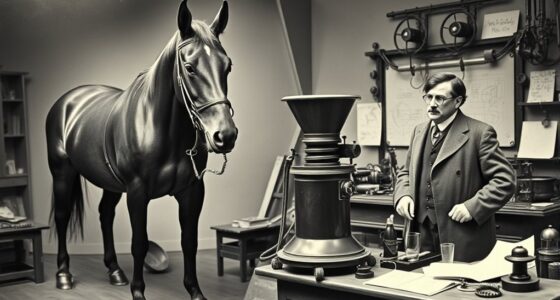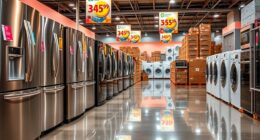The journey from ice boxes to smart fridges highlights centuries of innovation in food storage. Early methods used natural cool streams and ice to keep food fresh. Mechanical refrigeration then introduced consistent cooling, markedly reducing spoilage. Today, smart refrigerators connect to the internet, offer remote control, and feature sensors for ideal preservation. If you want to explore how these advancements continue to shape your kitchen, there’s more fascinating evolution ahead.
Key Takeaways
- Early food preservation relied on underground cellars, salting, smoking, and natural cool environments like snow and streams.
- Mechanical refrigeration introduced controlled cooling using gas compression, improving food safety and extending shelf life.
- Modern refrigeration features energy-efficient compressors, environmentally friendly refrigerants, and smart sensors for optimal performance.
- IoT-enabled smart fridges offer remote control, inventory tracking, and personalized settings, enhancing convenience and reducing waste.
- Future innovations include nanotechnology, biodegradable insulation, and AI integration for sustainable, intelligent food storage solutions.
Early Methods of Food Preservation
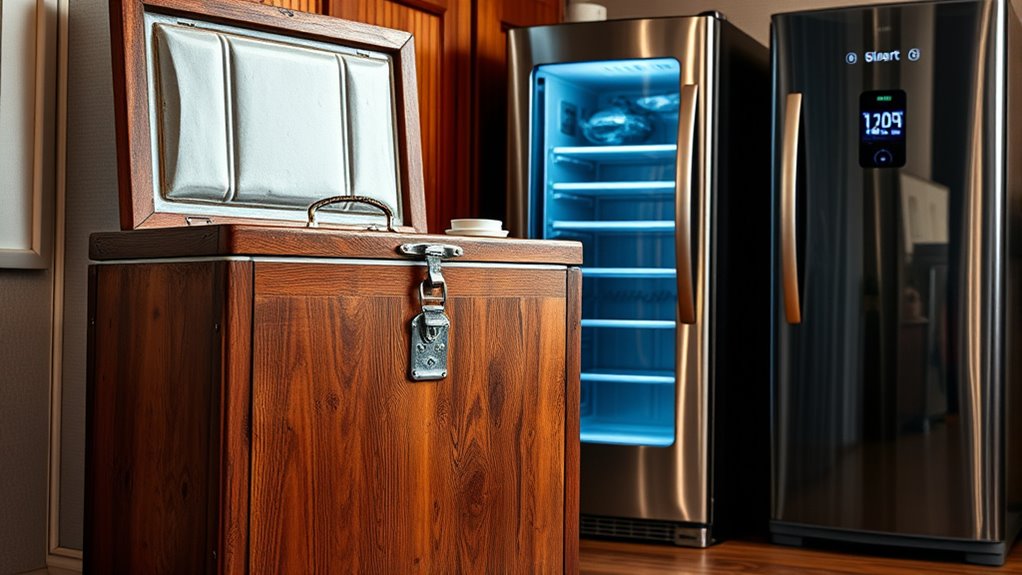
Before modern refrigerators, people relied on various traditional methods to keep food fresh. Historical methods included storing perishables in cool underground cellars, which maintained a steady temperature, especially in colder climates. Cultural practices also played a significant role; for example, salting, smoking, and drying meats and fish helped prevent spoilage. In some societies, foods were buried in ice or snow during winter, extending their freshness. Others used natural cool streams or wells to preserve dairy and produce. These methods varied widely across regions but shared the common goal of delaying decomposition. They reflect a deep understanding of local environments and resourcefulness. These traditional practices laid the foundation for modern refrigeration, demonstrating how cultural ingenuity adapted to meet food preservation needs over centuries. Additionally, the development of curiosity about natural cooling techniques contributed to innovations that eventually led to the invention of mechanical refrigeration systems.
The Birth of Mechanical Refrigeration
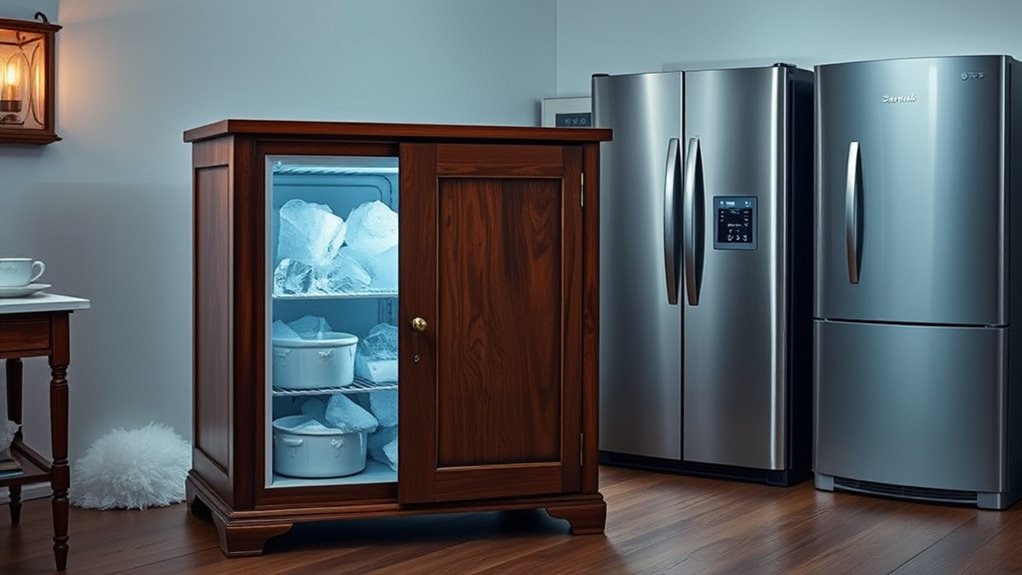
You’ll see how early refrigeration methods relied on natural cooling, which limited their effectiveness. The invention of mechanical systems revolutionized food storage by providing consistent and controllable cooling. This breakthrough markedly improved food preservation, extending shelf life and reducing waste. Additionally, advancements in temperature control technology further optimized these systems for various storage needs.
Early Refrigeration Techniques
Have you ever wondered how people first cooled their food without ice or natural refrigeration? Early techniques relied on methods like ice harvesting and salt curing. These approaches kept food fresh longer before mechanical systems emerged.
Additionally, some communities used refrigeration techniques to further preserve perishable items, laying the groundwork for modern appliances.
- Ice harvesting involved collecting ice from lakes in winter, then storing it in insulated ice houses.
- Salt curing used salt to draw moisture out of meats and fish, preventing spoilage.
- Cellar storage took advantage of cool, underground spaces to slow bacterial growth.
- Evaporative cooling, like wet cloths or misters, lowered temperatures naturally.
These techniques were essential in preserving food before the advent of mechanical refrigeration, helping communities extend shelf life and reduce waste.
Invention of Mechanical Systems
The invention of mechanical refrigeration revolutionized food storage by providing consistent, controllable cooling through machines. It relies on gas compression and thermodynamic cycles to transfer heat efficiently. You’ll notice that compressed gases, like ammonia or Freon, cycle through compression, condensation, expansion, and evaporation stages. This process absorbs heat from inside the system, cooling the environment. The key to this innovation is understanding thermodynamic cycles, which maximize energy transfer. In the table below, you see how different components work together:
| Component | Function | Key Principle |
|---|---|---|
| Compressor | Compresses refrigerant gases | Gas compression |
| Condenser | Releases heat to surroundings | Heat exchange |
| Expansion Valve | Lowers pressure of refrigerant | Thermodynamic cycle |
| Evaporator | Absorbs heat from food storage | Heat absorption |
| Refrigerant | Circulates, enabling cooling | Thermodynamic cycle |
Additionally, advancements in mechanical systems have allowed refrigerators to become more energy-efficient and reliable over time.
Impact on Food Preservation
How did mechanical refrigeration transform food preservation? It revolutionized the way you keep food safe and retain nutritional quality. With reliable cooling, spoilage decreased, and you could store perishable items longer. This innovation led to significant improvements, such as:
- Better food safety by reducing bacteria growth
- Preservation of nutrients in fruits, vegetables, and meats
- Extended shelf life, minimizing waste
- Greater variety of fresh foods available year-round
- The development of Gold IRA Rollovers, which allow for diversified retirement investments including precious metals, ensuring long-term financial security.
Advancements in Domestic Refrigeration
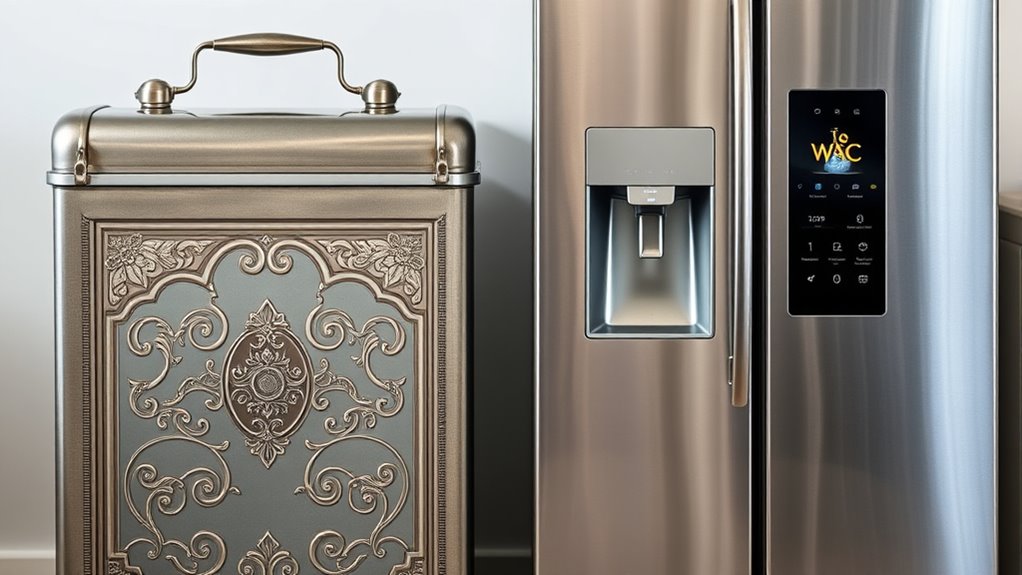
What recent innovations have truly transformed domestic refrigeration? Today’s refrigerators focus heavily on energy efficiency, helping you save on electricity bills while reducing environmental impact. Modern models use advanced insulation and compressor technology to consume less power without sacrificing performance. Inverter compressors adjust their speed based on cooling needs, making operation smoother and more efficient. Additionally, environmentally friendly refrigerants like R600a and R134a minimize harmful emissions. Smart sensors monitor internal temperatures and optimize compressor activity, ensuring ideal preservation with minimal energy use. These developments not only lower your carbon footprint but also make your appliance more reliable and cost-effective. Furthermore, advancements in AI-driven diagnostics enable proactive maintenance, extending appliance lifespan and improving user experience. Overall, these advancements make modern refrigerators more eco-conscious, aligning convenience with sustainability and responsible energy consumption.
The Rise of Electric and Compact Models
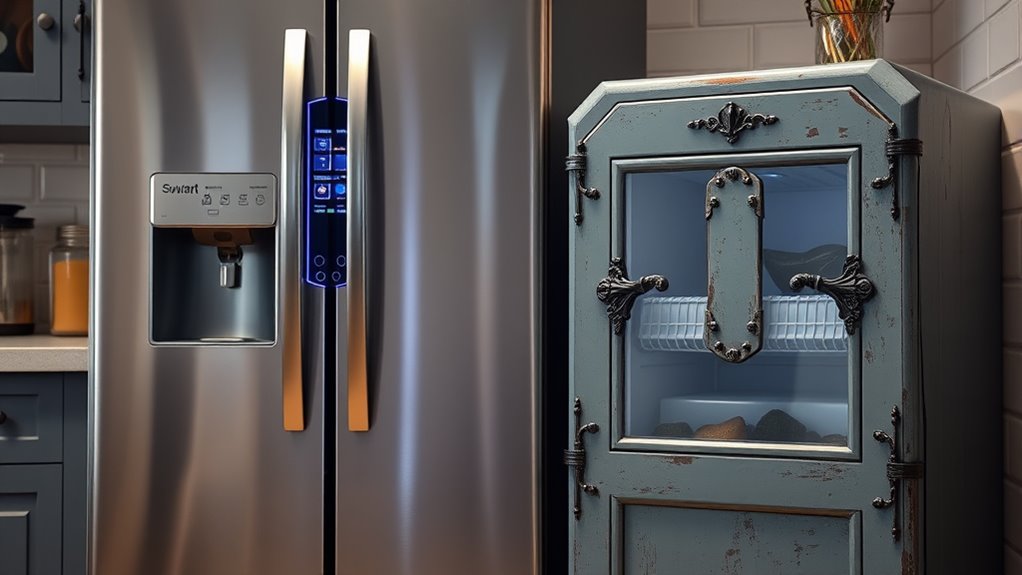
As urban living spaces become smaller and lifestyles busier, electric and compact refrigerators have gained popularity for their convenience and efficiency. These models suit small apartments, dorms, and offices, offering practical solutions. They emphasize energy efficiency, helping you save on electricity bills while reducing environmental impact. Design innovations make compact refrigerators more versatile and stylish, fitting seamlessly into modern homes. Additionally, incorporating aesthetic wall organization solutions can enhance the overall look and functionality of your living space, complementing your refrigerator setup.
The Era of Smart and Connected Refrigerators
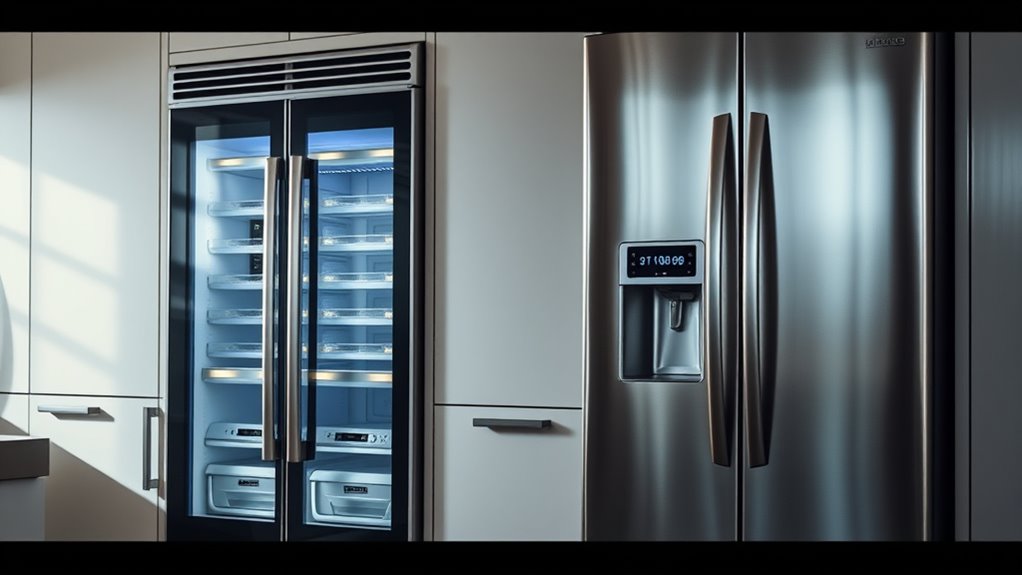
Smart refrigerators connected to the Internet offer you greater convenience and control over your kitchen. With IoT integration, you can monitor and manage your fridge remotely, saving time and reducing waste. This new era makes your everyday routines more efficient and hassle-free. Additionally, some smart fridges incorporate features like automated inventory tracking, which help you keep track of food expiration dates and suggest grocery lists.
IoT Integration Benefits
The integration of Internet of Things (IoT) technology has transformed refrigerators into intelligent appliances that seamlessly connect to your home network. This enables you to enjoy several benefits:
- Remote monitoring allows you to check your fridge’s contents or temperature from anywhere, reducing waste and ensuring ideal freshness.
- Personalized settings let you customize temperature zones and alerts based on your preferences.
- You can receive real-time notifications for open doors or low supplies, enhancing security and convenience.
- IoT integration also facilitates automatic grocery updates, saving you time and effort.
- Advanced tuning options in connected appliances can optimize energy consumption and extend appliance lifespan.
These features make managing your fridge easier and more efficient, giving you greater control and peace of mind in your daily routine.
Convenience and Efficiency
With IoT integration making refrigerators more connected, managing your appliance has become considerably more convenient and efficient. Smart fridges optimize energy efficiency by adjusting cooling based on usage patterns, reducing energy waste. They also enhance user convenience through features like real-time inventory tracking, remote temperature adjustments, and alerts for expired items. This connectivity allows you to plan meals better and minimize food spoilage. Additionally, inspirational quotes about fatherhood can remind us of the importance of caring for and nurturing our loved ones, just as these advanced appliances do for our food.
Future Trends and Innovations in Food Storage

As technology advances, future food storage solutions are set to become more efficient, sustainable, and user-friendly. You can expect innovations like nanotechnology innovations to improve insulation and food preservation. Biodegradable insulation will likely replace traditional materials, reducing environmental impact. Here are some key trends to watch for:
- Smart sensors that monitor freshness and automatically adjust temperature.
- Nanotech coatings that prevent bacterial growth and spoilage.
- Biodegradable insulation for eco-friendly, sustainable refrigeration.
- Integration of AI to optimize energy use and inventory management.
These advancements will help you save energy, reduce waste, and enjoy fresher food, all while supporting a greener planet. The future of food storage is getting smarter, more sustainable, and more tailored to your needs.
Frequently Asked Questions
How Do Traditional Ice Boxes Compare to Modern Refrigerators in Energy Efficiency?
You’ll notice that traditional ice boxes rely on ice for cooling, which isn’t energy-efficient, especially since ice box insulation isn’t as effective as modern materials. Manual cooling requires regularly replacing the ice, wasting energy and resources. Modern refrigerators use advanced insulation and compressor technology, making them much more energy-efficient. They maintain consistent temperatures without manual effort, saving you energy and money over time, unlike the old ice box method.
What Materials Were Used in Early Ice Box Construction?
Imagine a sturdy wooden box, its rough-hewn planks enclosing chilly ice. Early ice boxes used wooden compartments, often lined with zinc or tin, to hold ice and keep food cold. Ice box insulation was simple, relying on thick wood and sometimes straw or sawdust to slow heat transfer. These materials created a basic barrier, preserving perishables before modern insulation techniques improved efficiency and design.
How Did Refrigeration Technology Impact Global Food Distribution?
Refrigeration technology transformed global food distribution by enabling longer food preservation and expanding the global supply chain. You can now access fresh produce and perishable goods from distant regions, improving food security worldwide. This innovation reduces waste, lowers transportation costs, and allows for consistent availability of diverse foods year-round. As a result, refrigeration has made global markets more interconnected, ensuring that fresh food reaches consumers regardless of local seasonal limitations.
Are Smart Refrigerators Energy-Efficient Compared to Older Models?
Imagine stepping into a world where your fridge is smarter than your smartphone—yes, smart refrigerators are more energy-efficient than older models. They use advanced sensors and eco-friendly features to reduce energy consumption, saving you money and helping the environment. Unlike vintage ice boxes, these modern appliances optimize cooling and monitor usage, making them a sustainable choice. So, if you want efficiency and eco-friendliness, smart fridges are definitely the way to go.
What Are the Environmental Implications of Current Refrigeration Innovations?
You should consider the environmental implications of current refrigeration innovations, such as reduced refrigerant leakage and eco-friendly materials. These advances help minimize harmful emissions that contribute to climate change. However, increased plastic packaging from advanced features can lead to waste if not properly recycled. Overall, while innovations aim to improve efficiency, you need to stay aware of challenges like refrigerant leaks and plastic waste to support sustainability efforts.
Conclusion
Now that you’ve seen the stunning shift from simple ice boxes to smart, sophisticated refrigerators, it’s clear innovation ignites improvement. As technology takes a tantalizing turn, your kitchen becomes more convenient, connected, and clever. Embrace these evolving evolutions, and get ready for a future where food stays fresher, functions faster, and refrigerators become even more remarkable. The journey from basic boxes to brilliant breakthroughs promises a future full of fascinating features and fantastic food preservation.
